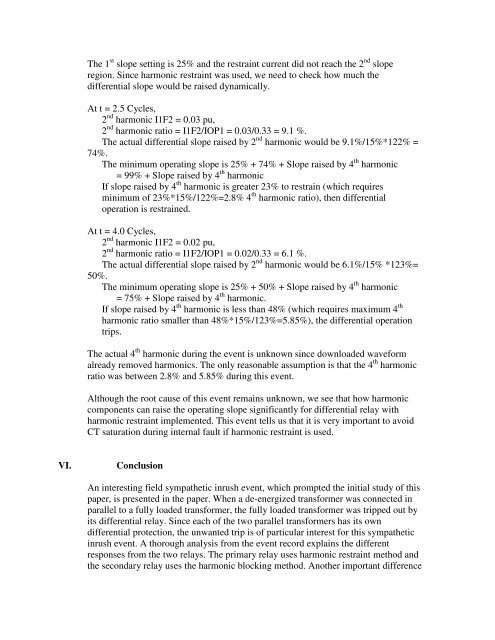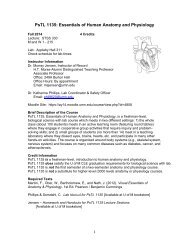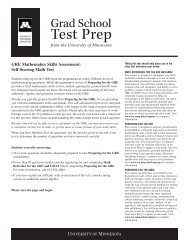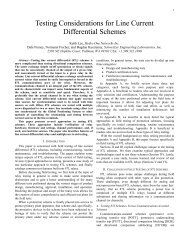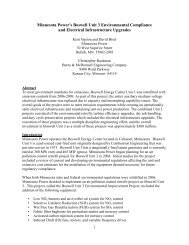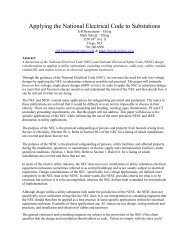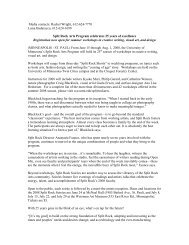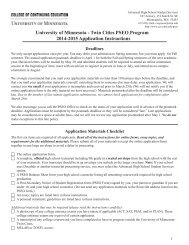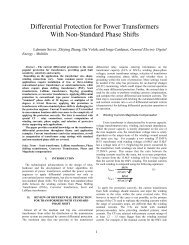Understanding Differences in Harmonic Restraint and Harmonic ...
Understanding Differences in Harmonic Restraint and Harmonic ...
Understanding Differences in Harmonic Restraint and Harmonic ...
- No tags were found...
Create successful ePaper yourself
Turn your PDF publications into a flip-book with our unique Google optimized e-Paper software.
The 1 st slope sett<strong>in</strong>g is 25% <strong>and</strong> the restra<strong>in</strong>t current did not reach the 2 nd sloperegion. S<strong>in</strong>ce harmonic restra<strong>in</strong>t was used, we need to check how much thedifferential slope would be raised dynamically.At t = 2.5 Cycles,2 nd harmonic I1F2 = 0.03 pu,2 nd harmonic ratio = I1F2/IOP1 = 0.03/0.33 = 9.1 %.The actual differential slope raised by 2 nd harmonic would be 9.1%/15%*122% =74%.The m<strong>in</strong>imum operat<strong>in</strong>g slope is 25% + 74% + Slope raised by 4 th harmonic= 99% + Slope raised by 4 th harmonicIf slope raised by 4 th harmonic is greater 23% to restra<strong>in</strong> (which requiresm<strong>in</strong>imum of 23%*15%/122%=2.8% 4 th harmonic ratio), then differentialoperation is restra<strong>in</strong>ed.At t = 4.0 Cycles,2 nd harmonic I1F2 = 0.02 pu,2 nd harmonic ratio = I1F2/IOP1 = 0.02/0.33 = 6.1 %.The actual differential slope raised by 2 nd harmonic would be 6.1%/15% *123%=50%.The m<strong>in</strong>imum operat<strong>in</strong>g slope is 25% + 50% + Slope raised by 4 th harmonic= 75% + Slope raised by 4 th harmonic.If slope raised by 4 th harmonic is less than 48% (which requires maximum 4 thharmonic ratio smaller than 48%*15%/123%=5.85%), the differential operationtrips.The actual 4 th harmonic dur<strong>in</strong>g the event is unknown s<strong>in</strong>ce downloaded waveformalready removed harmonics. The only reasonable assumption is that the 4 th harmonicratio was between 2.8% <strong>and</strong> 5.85% dur<strong>in</strong>g this event.Although the root cause of this event rema<strong>in</strong>s unknown, we see that how harmoniccomponents can raise the operat<strong>in</strong>g slope significantly for differential relay withharmonic restra<strong>in</strong>t implemented. This event tells us that it is very important to avoidCT saturation dur<strong>in</strong>g <strong>in</strong>ternal fault if harmonic restra<strong>in</strong>t is used.VI.ConclusionAn <strong>in</strong>terest<strong>in</strong>g field sympathetic <strong>in</strong>rush event, which prompted the <strong>in</strong>itial study of thispaper, is presented <strong>in</strong> the paper. When a de-energized transformer was connected <strong>in</strong>parallel to a fully loaded transformer, the fully loaded transformer was tripped out byits differential relay. S<strong>in</strong>ce each of the two parallel transformers has its owndifferential protection, the unwanted trip is of particular <strong>in</strong>terest for this sympathetic<strong>in</strong>rush event. A thorough analysis from the event record expla<strong>in</strong>s the differentresponses from the two relays. The primary relay uses harmonic restra<strong>in</strong>t method <strong>and</strong>the secondary relay uses the harmonic block<strong>in</strong>g method. Another important difference


